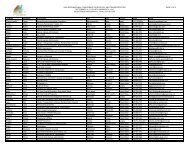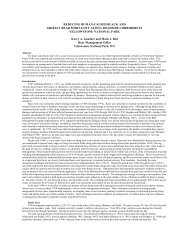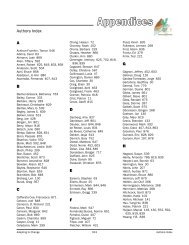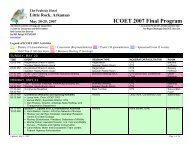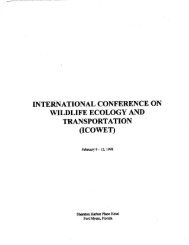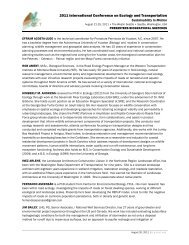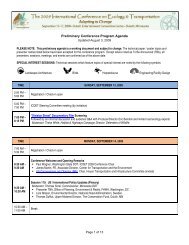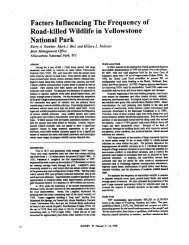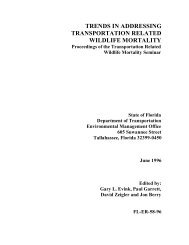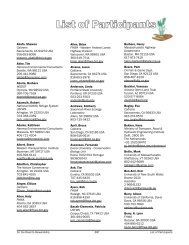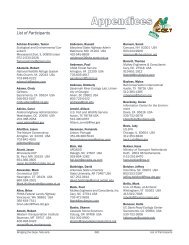DISCUSSION AND MANAGEMENT CONSIDERATIONSWildlife Vehicle Collision DataUS 6Initially, coarser scale analyses were used to identify where wildlife mitigation might be needed. A report entitled “Deer-Vehicle Crash Hotspots in Utah: Data for Effective Mitigation” (Kassar and Bissonette 2005) used traffic and safetydata from UDOT to identify the highest occurrence of deer-vehicle collisions and hence where mitigation might betargeted. UDOT’s traffic and safety data includes only those accidents reported to the agency by public safety officialsresulting from significant property damage, personal injury, or both, and as a result, underestimates the number ofWVCs that actually occur. The other was a linkage analysis funded by UDOT shortly after the completion of the final EISfor US 6. This analysis used existing GIS information, and on-the-ground knowledge from land management, wildlife,and transportation agency personnel, to identify locations where fish and wildlife resources were a concern, and to helpwith the planning and coordination of mitigation measures (Ruediger 2007). The linkage analysis process wasimportant for looking at fish and wildlife needs on a large corridor scale. Once hotspots and/or high priority linkagezones were identified, the location specific WVC data could then be used with these other analyses to “fine-tune” wheremitigation was warranted, and what options might be used to meet objectives.Prior to any wildlife mitigation being accomplished, wildlife managers and transportation officials had to betterunderstand one another’s position, and better define the magnitude of the problem that vehicle traffic on the US 6corridor was having on public safety and wildlife mortality. The WVC data, in part, provided the information needed thatallowed this to happen. In the final EIS for US 6, it was reported that 28% of all motor vehicle accidents along this routecould be attributed to collisions with wildlife, stating that between 1991-2000, about 1,100 accidents involving wildlifeoccurred, or an average of 110 per year (US 6 FEIS 2005). As previously mentioned, because traffic and safety dataincludes only those accidents reported to the DOT by public safety officials resulting from significant property damage,personal injury, or both, wildlife managers knew that the reported level of WVCs contained in the EIS was extremelyconservative. At that time, however, they had nothing to back up this assertion.As a result, UDWR biologists requested the carcass removal data that UDOT had required of its contractors, andcommitted to analyze this information for a different look at the collision problem. Between the time that the draft EISwas issued for public comment in the fall of 2004, and when the final EIS was published in September 2005, analysisof the carcass pickup data showed that the actual number of WVCs was much higher than what had been indicated inthe EIS. As a result, UDOT and the Federal Highways Administration (FHWA) included reference to this in the Record-of-Decision (ROD), added the data summary to the administrative record, and committed that the WVC information wouldbe used to develop future mitigation measures (Record of Decision 2005).The ROD also directed FHWA and UDOT to create a wildlife coordinating committee made up of UDOT, UDWR, and otherentities to discuss wildlife needs and make mitigation recommendations as construction projects came online. For thenext several years, and continuing to the present time, this committee has met regularly to identify wildlife issues, andto provide wildlife mitigation recommendations for transportation reconstruction projects. Incidentally, the US 6 WildlifeCoordinating Committee was the recipient of a 2010 FHWA Exemplary Ecosystem Initiative Award for their partnershipefforts to ensure wildlife and wildlife habitat were mitigated during the long-term reconstruction of the US 6 corridor.I-70Concurrently with the collection of WVC data, UDOT initiated a linkage analysis for I-70 similar to that described abovefor US 6 (Ruediger et. al. 2007a). As was the case for US 6, the linkage analysis process identified the highest priorityareas where wildlife impacts were occurring, and hence, the most important areas for potential mitigation. In addition,a partner report to the linkage analysis provided specific wildlife mitigation recommendations for I-70, including thestretch that represents the study area in this paper (Ruediger et. al. 2007b). In the mitigation recommendations report,the authors specify that new underpass bridges should be placed between mileposts 5 and 6. In addition to numerouson-site visits, the WVC data that had been collected and analyzed were key in justifying this recommendation and inhelping to identify the exact location to place the underpasses (Bruce Bonebrake personal communication 2011).Intuitively, the documentation of road kills would be well suited for determining where wildlife crossings should belocated (Clevenger and Ford 2010), although some research suggests that this may not be the case (Clevenger et al.2002). It has also been suggested that road kill data should be combined with habitat linkage mapping or movementmodels in identifying the location of wildlife crossing structures (Clevenger and Ford 2010). The case studiespresented here show that Utah officials are aware of the limitations in using WVC data as a stand-alone source when<strong>ICOET</strong> 2011 Proceedings 188 Session <strong>COM</strong>-1
making wildlife mitigation recommendations, and that habitat linkage mapping, on-the-ground site visits, and otherstools should also be employed when making these decisions.Mitigation FeaturesThe newly constructed mitigation features on US 6 and I-70 are showing promising results. The mitigation featurespresented here were built with the largest wildlife species being the limiting factor, in this case mule deer and elk. Thebridged underpasses have shown use by a variety of species, and their general acceptance by mule deer isencouraging. Elk have shown little acceptance of most crossing structures in the past, and in Utah, very few elk (lessthan two dozen) have been documented using even large underpasses. With eight bull elk photographed using the I-70bridged underpass shortly after completion in 2010, transportation and wildlife officials are optimistic that this designmight be a model that can be used in the future.Wildlife Crossing Camera StudyIn reference to wildlife mitigation actions, Forman et al. (2003) indicated that evaluating the success of mitigation is oftenbased on opinion rather than research, and that few states have based their conclusions on research results. They alsoargue that there is an urgent need for rigorous evaluations, and that future mitigation should be tested and evaluated.The wildlife crossing camera study currently underway in Utah has been instrumental in evaluating the effectiveness ofa variety of mitigation features statewide. It is one of the few studies to place wildlife trail cameras at mitigation sitespre-construction. With this data we are able to compare the species and their numbers pre- and post-construction, andare able to better evaluate the efficacy of the crossings in passing a diversity of wildlife. The study has also played akey role in providing needed information that wildlife and transportation officials can use to plan and implement futureactions. Documenting which mitigation features are working, and at what level, is necessary if sufficient mitigationfeatures can be expected to be included in future transportation projects. The cost of effective wildlife mitigation issignificant, and without hard data showing they work, future mitigation options will be limited in both frequency andscope. Dr. Cramer’s research has provided the baseline needed for Utah officials to feel comfortable that the inclusionof wildlife mitigation infrastructure in transportation projects is a good investment, and that recent recommendationsfor type and size of structures is warranted. It is expected that this effort will continue through June 2013, upon whichtime, Utah officials feel they will have significantly improved their knowledge base and can make sound mitigationrecommendations in the future, both ecologically and financially.CONCLUSIONSTransportation projects are expensive, and the inclusion of wildlife mitigation features only adds to the cost. As aresult, careful analysis has to be done when wildlife mitigation recommendations are made. Although WVC data do notprovide all the answers, it can be useful, especially when used in concert with other tools, to document significantimpacts to wildlife populations and to provide the needed justification for mitigation actions to be carried out. The casestudies presented here show that WVC data is a valuable piece of the puzzle when trying to solve complex interactionsbetween transportation corridors and wildlife populations.ACKNOWLEDGMENTSThe authors thank Robert Hamlin and Megan Schwender for assisting Dr. Cramer in analyzing hundreds of thousandsof photos. Special thanks to UDOT, UDWR, the Mule Deer Foundation, Sportsmen for Fish and Wildlife, the RockyMountain Elk Foundation, and the Foundation for North American Wild Sheep for their support in funding Dr. Cramer’sresearch. Thanks to the US 6 Wildlife Coordinating Committee participants for their work in providing technicalassistance for mitigation recommendations, and to UDOT and FHWA for listening to those recommendations andincluding them in transportation projects.BIOGRAPHICAL SKETCHESAshley Green is a Wildlife Program Coordinator for the Utah Division of Wildlife Resources currently responsible formanaging the Division’s land and water assets and also works on wildlife-highway issues statewide. He earned B.S.and M.S. degrees from Brigham Young University in Conservation Biology-Wildlife and Range and Wildlife Resources.He has spent nearly 15 years with the Division in a variety of roles including vegetation monitoring, habitat restoration,lands management, and impact analysis.Reducing Wildlife-Vehicle Collisions 189 <strong>ICOET</strong> 2011 Proceedings



